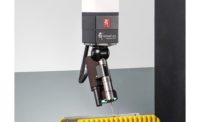Closing the Digital Loop – Engineering to Manufacturing
Today’s CAD models and quality standards bring modern manufacturing much closer to better communication.

Digital measurement data is collected from the SmartScope and analyzed in real time with software. When measurement data is compared to the 3D CAD model, the quality inspector can instantly verify dimensional and GD&T compliance. Source: KOTEM, a QVI company

When used as part of the design process, this software will explain to the designer GD&T features (left side) and optimize GD&T dimensioning (right side) for the CAD designer. Source: KOTEM, a QVI company

This software imports digital measurement data and produces in-process control charts, which are statistical tools used to assure consistent parts and process.



Referees at sporting events can fuel elation or outrage with their calls when it comes to a favorite team, but in truth, these people are needed to provide an impartial interpretation of the rules of the game.
In the world of design and manufacturing, the referee is the quality inspector, reading and interpreting the design drawing. Herein lies the problem in a world of modern high tolerance manufacturing, where an engineering design team communicates the manufacturing tolerances of a given part, and others downstream deal with interpretation about specification compliance while maintaining production output.
Modern Supply Chain Trends Create Design Challenges
The communication problem has become even more evident over the last few years with a continuing trend of separating the design team from the manufacturing team, in distance and organization. Even within the same company, geographical distance, native languages, and different standards create problems with communicating design intent. Additionally, the trend towards outsourcing production necessitates dealing with outside contractors that may have competing objectives and interests, often based on the premise that they are only getting paid for “good” parts.
Another challenge is the lean manufacturing movement that is focused on eliminating process waste. While the logistics of separating design centers from manufacturing has financial benefits, the trend of separating design engineering from manufacturing and quality engineering means that the design engineer has lost the ability to easily walk over to a machining or inspection area and gain insight into potentially significant design or process improvements.
Communication – Data Transparency for All
To overcome these communication challenges, more and more companies are turning to a model-based definition (MBD) strategy, in lieu of document-based communication. When using a MBD strategy, the digital CAD model becomes much more than the dimensions to which parts are measured and inspected. MBD keeps a complete digital information thread from design to manufacturing to inspection. Every part attribute is kept in a digital archive, which can include manufacturing methods and coordinate measuring machine (CMM) digital inspection results.
Another widely adopted strategy is adherence to quality standards such as geometric dimensioning and tolerancing (GD&T): ISO 1101 and ASME Y14.5. GD&T has been used in the design process for many years and is an essential tool for communicating design intent and ensuring parts meet the desired fit, form, function and assembly.
GD&T allows the designer to provide a universal conceptual design language, including datum references, degrees of freedom, surface boundaries and axis methods of integration, profile tolerances, symbology and modifier tools.
The central concept behind model-based definition (MBD) is that the digital model contains all the detailed information necessary to produce and reproduce a part. MBD that includes GD&T communicates complete design intent to manufacturing and quality inspection.
Most modern CAD design is done using 3D models. When properly managed with the MBD concept, the CAD model will continue to have digital manufacturing attributes added to it throughout the life cycle of the part. In the end, the MBD CAD model will be the design authority, containing all data needed to reproduce the part, all the way through inspection. When employing an MBD strategy the “perfect part” becomes virtual.
To assist design engineers with GD&T standards, many companies use CAD software “add-ons” or standalone programs to optimize tolerancing and provide advice in understanding specific parts of the design standard being used. These programs have the ability to import native 3D models from CAD software, and import dimensional inspection points (from any CMM) for a comprehensive GD&T tolerance analysis, fully compliant to the ASME Y14.5 specification.
Globalization and outsourcing have made the task of communicating design intent and meeting part specifications through documentation not a choice but a requirement. Geographical distance and subcontracting production make the digital thread very thin and force a higher burden on the design team to communicate manufacturing and inspection information through a formal method like MBD and GD&T.
In a modern supply chain model, any given part could be manufactured in three separate factories with different machines using three different machining operations. A digital thread is paramount to assure consistent and compliant parts, no matter what the source or fabrication method. Even when a product is designed using an engineering standard (ASME Y14.5, etc.) there can be human interpretative issues. Using GD&T dimensional analysis software gives formalized and consistent reporting of CMM digital measurement results.
For confidentiality reasons, some sophisticated product brands do not share their 3D models with their contract manufacturers. Instead, they generate a 2D drawing and provide tolerancing information as text fields on the drawing. This can create a rich area for debate between what the brand company deems acceptable and what the contract manufacturer thinks is a good part. Dimensional analysis software alleviates this problem by providing a consistent reporting method of CMM digital measurement results.
Achieving Lean
Lean manufacturing focuses on reducing or eliminating waste in a manufacturing process. The traditional product development model of “design-make-measure,” generally results in multiple development iterations, each making an incremental improvement in part or process. The use of a 3D CAD digital thread and simulation modeling software tools could result in the number of iterations being reduced to one. The benefit would be a minimum number of prototypes and first article inspections needed to approve tooling and capability. This approach reduces cost and improves time-to-market for new product development.
Further, manufacturing engineering can apply unique knowledge of machine capabilities to meet specified tolerances. Using dimensional analysis software reporting, feedback to design engineering through the digital thread means the design team learns the limits of the manufacturing processes and whether the tolerance specifications are too extreme. An informed decision may be made to decide if tolerances could be relaxed, based on manufacturing process results.
Make Communication a Best Practice
Even the most advanced software won’t bring success without an enterprise culture of open communication. Today’s CAD models and quality standards bring modern manufacturing much closer to better communication throughout the supply chain, but it is still not complete without developing good practices:
Design engineering should provide tolerance information in an understandable and standard format for downstream users, minimizing interpretation issues.
Design engineering should optimize and validate GD&T values in a consistent manner.
“Design – Make – Measure” development process should include closing the information loop by providing digital measurement data feedback to design and manufacturing teams for learning purposes (via the digital thread).
Digital measurement data should be reported in a consistent format so that all parties, regardless of department or location, can agree on what parts are “good or bad.”
Beyond “Design – Make – Measure”
Reported measurement data from a CMM determines when a part is “good or bad,” based on nominal dimensions and stated tolerances. Statistical process control (SPC) has been mainstream for many years, and successful companies use SPC charts to monitor and improve their manufacturing processes. There are dozens of commercially available SPC software packages that are compatible with existing CMM measurement data. The benefits of SPC implementation are substantial and generally, result in quick return on investment.
Fewer companies embrace the full power of providing SPC data as useful feedback to the design team via the digital thread of MBD. And even fewer companies take that same digital data into an enterprise level product lifecycle management (PLM) system for an overall holistic view of product tolerances.
Industry 4.0 on the Horizon
Companies will continue to explore manufacturing information systems with the goal of improving their operational performance. Digital data collection and the availability of that data will drive higher awareness when evaluating manufacturing metrics. Industry 4.0 will be a driving force in the evolution of digital data transparency, with the winners being companies that have the most visionary management teams.
Looking for a reprint of this article?
From high-res PDFs to custom plaques, order your copy today!








